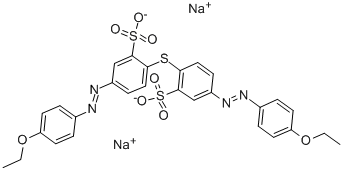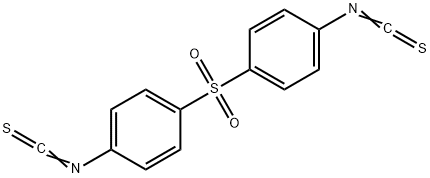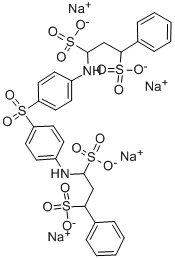4,4'-THIODIANILINE
Synonym(s):4,4′-Thiodianiline
- CAS NO.:139-65-1
- Empirical Formula: C12H12N2S
- Molecular Weight: 216.3
- MDL number: MFCD00025342
- EINECS: 205-370-9
- SAFETY DATA SHEET (SDS)
- Update Date: 2023-10-17 13:55:13

What is 4,4'-THIODIANILINE?
Chemical properties
A brown-purple powder or needles.
The Uses of 4,4'-THIODIANILINE
4,4′-Thiodianiline was used almost exclusively as a chemical intermediate in the production of three dyes: C.I. mordant yellow 16, milling red G, and milling red FR. However, only mordant yellow 16 had any commercial significance in the United States (IARC 1982, HSDB 2009); it was used to dye wool and for printing on wool, silk, and cotton (SDC 1971). Mordant yellow 16 has been used as an indicator in the U.S. government’s nerve gas detector program (SOCMA 2002). However, no uses of either 4,4′-thiodianiline or mordant yellow 16 since the early 1990s have been reported.
The Uses of 4,4'-THIODIANILINE
4,4'-Thiodianiline is a carcinogenic aromatic amine used in the textile industry. It can also be used to modify electrodes in solar cells. Dyes and metabolites, Environmental Testing.
The Uses of 4,4'-THIODIANILINE
4,4′-Diaminodiphenyl sulfide may be employed for the fabrication of quantum wires and quantum dots by chemical vapor deposition.
It may be used for the preparation of the following:
- polypyromellitimides
- sulfur-containing copolyimides
- polyamides
Definition
ChEBI: 4,4'-Thiodianiline is a substituted aniline.
General Description
4,4'-Thiodianiline is a substituted aniline. It is a brown to violet colored solid aromatic amine that emits toxic fumes of nitrogen oxides, carbon monoxide, carbon dioxide, nitrogen and sulfur oxides when heated to decomposition. 4,4'-Thiodianiline is primarily used as a chemical intermediate in the production of certain dyes.
Air & Water Reactions
Insoluble in water.
Reactivity Profile
4,4'-THIODIANILINE is incompatible with acids, diazo and azo compounds, halocarbons, isocyanates, aldehydes, alkali metals, nitrides, hydrides, and other strong reducing agents. May generate heat with these materials and hydrogen gas or hydrogen sulfide gas. May liberate hydrogen sulfide if heated to decomposition or mixed with an acid. Also incompatible with peroxides, phenols (acidic), epoxides, anhydrides, and acid halides.
Health Hazard
ACUTE/CHRONIC HAZARDS: When heated to decomposition 4,4'-THIODIANILINE emits very toxic fumes.
Fire Hazard
Flash point data for 4,4'-THIODIANILINE are not available, however 4,4'-THIODIANILINE is probably combustible.
Safety Profile
Confirmed carcinogen with experimental carcinogenic and tumorigenic data. Poison by intravenous route. Moderately toxic by ingestion. Experimental reproductive effects. Mutation data reported. When heated to decomposition it emits very toxic fumes of NOx and SOx. See also SULFIDES.
Potential Exposure
4,40-Thiodianiline is used as a dye intermediate; in organic sythesis; as a lab reagent. Antiplatyhelmintic agents; Carcinogens
Carcinogenicity
4,4′-Thiodianiline is reasonably anticipated to be a human carcinogen based on sufficient evidence of carcinogenicity from studies in experimental animals.
Shipping
UN3077 Environmentally hazardous substances, solid, n.o.s., Hazard class: 9; Labels: 9Miscellaneous hazardous material, Technical Name Required. UN3143 dye intermediates, solid, toxic, n.o.s., Hazard Class: 6.1; Labels: 6.1-Poisonous materials, Technical Name Required.
Purification Methods
The free base is used for the detection of NO3 ions. The diacetate crystallises from aqueous AcOH with m 182o and the sulfoxide, m 184o, forms prisms from EtOH or H2O. [Fuson & Melamed J Org Chem 13 690 I1948, Beilstein 1 3 III 1246, 13, IV 1246.]
Incompatibilities
This material may be combustible. 4,40-Thiodianiline is incompatible with acids, diazo and azo compounds, halocarbons, isocyanates, aldehydes, alkali metals, nitrides, hydrides, and other strong reducing agents. May generate heat with these materials and hydrogen gas or hydrogen sulfide gas. May liberate hydrogen sulfide if heated to decomposition or mixed with an acid. Also incompatible with peroxides, phenols (acidic), epoxides, anhydrides, and acid halides. Light and moisture sensitive
Waste Disposal
It is inappropriate and possibly dangerous to the environment to dispose of expired or waste drugs and pharmaceuticals by flushing them down the toilet or discarding them to the trash. Household quantities of expired or waste pharmaceuticals may be mixed with wet cat litter or coffee grounds, double-bagged in plastic, discard in trash. Larger quantities shall carefully take into consideration applicable DEA, EPA, and FDA regulations. If possible return the pharmaceutical to the manufacturer for proper disposal being careful to properly label and securely package the material. Alternatively, the waste pharmaceutical shall be labeled, securely packaged and transported by a state licensed medical waste contractor to dispose by burial in a licensed hazardous or toxic waste landfill or incinerator.
Properties of 4,4'-THIODIANILINE
| Melting point: | 105-107 °C(lit.) |
| Boiling point: | 361 °C |
| Density | 1.1391 (rough estimate) |
| refractive index | 1.5700 (estimate) |
| storage temp. | Keep in dark place,Inert atmosphere,Room temperature |
| solubility | DMSO (Slightly), Methanol (Slightly) |
| form | neat |
| pka | 4.55±0.10(Predicted) |
| color | Pale Brown |
| BRN | 1875513 |
| CAS DataBase Reference | 139-65-1(CAS DataBase Reference) |
| IARC | 2B (Vol. 27, Sup 7) 1987 |
| NIST Chemistry Reference | Benzenamine, 4,4'-thiobis-(139-65-1) |
| EPA Substance Registry System | 4,4'-Thiodianiline (139-65-1) |
Safety information for 4,4'-THIODIANILINE
| Signal word | Danger |
| Pictogram(s) |
 Exclamation Mark Irritant GHS07  Health Hazard GHS08  Environment GHS09 |
| GHS Hazard Statements |
H302:Acute toxicity,oral H350:Carcinogenicity H411:Hazardous to the aquatic environment, long-term hazard |
| Precautionary Statement Codes |
P202:Do not handle until all safety precautions have been read and understood. P264:Wash hands thoroughly after handling. P264:Wash skin thouroughly after handling. P270:Do not eat, drink or smoke when using this product. P273:Avoid release to the environment. P301+P312:IF SWALLOWED: call a POISON CENTER or doctor/physician IF you feel unwell. P308+P313:IF exposed or concerned: Get medical advice/attention. |
Computed Descriptors for 4,4'-THIODIANILINE
| InChIKey | ICNFHJVPAJKPHW-UHFFFAOYSA-N |
New Products
4-AMINO-TETRAHYDRO-PYRAN-4-CARBOXYLIC ACID HCL 4-(Dimethylamino)tetrahydro-2H-pyran-4-carbonitrile 4-Aminotetrahydropyran-4-carbonitrile Hydrochloride (R)-3-Aminobutanenitrile Hydrochloride 3-((Dimethylamino)methyl)-5-methylhexan-2-one oxalate 1,4-Dioxa-8-azaspiro[4.5]decane 5-Bromo-2-nitropyridine Nimesulide BP Aceclofenac IP/BP/EP Diclofenac Sodium IP/BP/EP/USP Mefenamic Acid IP/BP/EP/USP Ornidazole IP Diclofenac Potassium THOMAIND PAPER PH 2.0 TO 4.5 1 BOX BUFFER CAPSULE PH 9.2 - 10 CAP SODIUM CHLORIDE 0.1N CVS ALLOXAN MONOHYDRATE 98% PLATINUM 0.5% ON 3 MM ALUMINA PELLETS (TYPE 73) LITHIUM AAS SOLUTION 2-Bromo-1-(bromomethyl)-3-chloro-5-nitrobenzene 2-Bromo-3-nitroaniline N-(3-Hydroxypropyl)-N-methylacetamide 3-Bromo-6-chloropyridazine 4-ethyl-3-nitrobenzoic acidRelated products of tetrahydrofuran






![1-[(2,4-DINITROPHENYL)THIO]-2,4-DINITROBENZENE](https://img.chemicalbook.in/StructureFile/ChemBookStructure1/GIF/CB9348129.gif)

You may like
-
 Bis(4-aminophenyl) Sulfide CAS 139-65-1View Details
Bis(4-aminophenyl) Sulfide CAS 139-65-1View Details
139-65-1 -
 4,4′-Diaminodiphenyl sulfide CAS 139-65-1View Details
4,4′-Diaminodiphenyl sulfide CAS 139-65-1View Details
139-65-1 -
 Anti-ARSD antibody produced in rabbit CASView Details
Anti-ARSD antibody produced in rabbit CASView Details -
 4,4′-Diaminodiphenyl sulfide CAS 139-65-1View Details
4,4′-Diaminodiphenyl sulfide CAS 139-65-1View Details
139-65-1 -
 Anti-ARSD antibody produced in rabbit CASView Details
Anti-ARSD antibody produced in rabbit CASView Details -
 1823368-42-8 98%View Details
1823368-42-8 98%View Details
1823368-42-8 -
 2-(3-(tert-butyl)phenoxy)-2-methylpropanoic acid 1307449-08-6 98%View Details
2-(3-(tert-butyl)phenoxy)-2-methylpropanoic acid 1307449-08-6 98%View Details
1307449-08-6 -
 Lithium ClavulanateView Details
Lithium ClavulanateView Details
61177-44-4